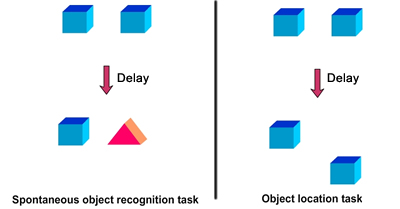Memory
Visual recognition memory
Recognition neurons
One form of learning that we all use every minute of every day may be the best chance of substantiating a direct link between a form of learning and an experimentally derived form of synaptic plasticity - visual recognition memory and LTD. The visual recognition memory system that resides in a region of the brain known as the perirhinal cortex . Certain neurons in this area respond in such a way as to discriminate between objects that have not been seen before (novelty neurons), those that have been seen before (familiarity neurons) and those that have been seen recently (recency neurons). In each case, the response of the neuron is decreased following stimulation. Thus, a novelty neuron responds strongly when presented with a novel object, but less strongly when that object is presented for a second or third time.
Spontaneous object recognition
There are many different tasks that can be used to investigate recognition memory. One of the simplest is the spontaneous object recognition task. In this task, a rat or mouse is placed in an arena with two identical objects and allowed to explore them. After a while, the animal is removed for a pre-determined period of time and then returned to the arena where an identical copy of the original object (familiar object) is still in place along with a new object that the animal has not seen before (novel object). The rat or mouse will then tend to explore the novel object more than the familiar one. And its not just rodents that do this - we do it as well! Loss of function in the perirhinal cortex results in a loss in the ability to perform this task .... ie the animal loses the ability to recognise that they've seen the object before.
Spatial Recognition Memory

The combination of knowing whether you have seen something before and where you have seen it before is combined to give us visual recognition memory. We have seen that this relatively simple form of memory requires multiple regions of the brain to achieve. Indeed, a third brain region, the medial prefrontal cortex, is also required to integrate the information from the hippocampus and perirhinal cortex together. Thus, even simple things require a complex series of computations and network interactions. More detailed information on memory systems is available.

